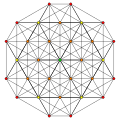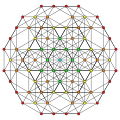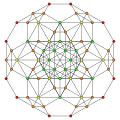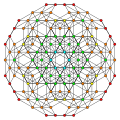Top Qs
Timeline
Chat
Perspective
Rectified 5-simplexes
From Wikipedia, the free encyclopedia
Remove ads
In five-dimensional geometry, a rectified 5-simplex is a convex uniform 5-polytope, being a rectification of the regular 5-simplex.
There are three unique degrees of rectifications, including the zeroth, the 5-simplex itself. Vertices of the rectified 5-simplex are located at the edge-centers of the 5-simplex. Vertices of the birectified 5-simplex are located in the triangular face centers of the 5-simplex.
Remove ads
Rectified 5-simplex
Summarize
Perspective
In five-dimensional geometry, a rectified 5-simplex is a uniform 5-polytope with 15 vertices, 60 edges, 80 triangular faces, 45 cells (30 tetrahedral, and 15 octahedral), and 12 4-faces (6 5-cell and 6 rectified 5-cells). It is also called 03,1 for its branching Coxeter-Dynkin diagram, shown as ![]()
![]()
![]()
![]()
![]()
![]()
![]() .
.
E. L. Elte identified it in 1912 as a semiregular polytope, labeling it as S1
5.
Alternate names
- Rectified hexateron (Acronym: rix) (Jonathan Bowers)
Coordinates
The vertices of the rectified 5-simplex can be more simply positioned on a hyperplane in 6-space as permutations of (0,0,0,0,1,1) or (0,0,1,1,1,1). These construction can be seen as facets of the rectified 6-orthoplex or birectified 6-cube respectively.
As a configuration
This configuration matrix represents the rectified 5-simplex. The rows and columns correspond to vertices, edges, faces, cells and 4-faces. The diagonal numbers say how many of each element occur in the whole rectified 5-simplex. The nondiagonal numbers say how many of the column's element occur in or at the row's element.[1][2]
The diagonal f-vector numbers are derived through the Wythoff construction, dividing the full group order of a subgroup order by removing one mirror at a time.[3]
Images
 Stereographic projection of spherical form |
Related polytopes
The rectified 5-simplex, 031, is second in a dimensional series of uniform polytopes, expressed by Coxeter as 13k series. The fifth figure is a Euclidean honeycomb, 331, and the final is a noncompact hyperbolic honeycomb, 431. Each progressive uniform polytope is constructed from the previous as its vertex figure.
Remove ads
Birectified 5-simplex
Summarize
Perspective
The birectified 5-simplex is isotopic, with all 12 of its facets as rectified 5-cells. It has 20 vertices, 90 edges, 120 triangular faces, 60 cells (30 tetrahedral, and 30 octahedral).
E. L. Elte identified it in 1912 as a semiregular polytope, labeling it as S2
5.
It is also called 02,2 for its branching Coxeter-Dynkin diagram, shown as ![]()
![]()
![]()
![]()
![]() . It is seen in the vertex figure of the 6-dimensional 122,
. It is seen in the vertex figure of the 6-dimensional 122, ![]()
![]()
![]()
![]()
![]()
![]()
![]() .
.
Alternate names
- Birectified hexateron
- dodecateron (Acronym: dot) (For 12-facetted polyteron) (Jonathan Bowers)
Construction
The elements of the regular polytopes can be expressed in a configuration matrix. Rows and columns reference vertices, edges, faces, and cells, with diagonal element their counts (f-vectors). The nondiagonal elements represent the number of row elements are incident to the column element.[4][5]
The diagonal f-vector numbers are derived through the Wythoff construction, dividing the full group order of a subgroup order by removing one mirror at a time.[6]
Images
The A5 projection has an identical appearance to Metatron's Cube.[7]
Intersection of two 5-simplices
 |
The birectified 5-simplex is the intersection of two regular 5-simplexes in dual configuration. The vertices of a birectification exist at the center of the faces of the original polytope(s). This intersection is analogous to the 3D stellated octahedron, seen as a compound of two regular tetrahedra and intersected in a central octahedron, while that is a first rectification where vertices are at the center of the original edges.
 |
| Dual 5-simplexes (red and blue), and their birectified 5-simplex intersection in green, viewed in A5 and A4 Coxeter planes. The simplexes overlap in the A5 projection and are drawn in magenta. |
It is also the intersection of a 6-cube with the hyperplane that bisects the 6-cube's long diagonal orthogonally. In this sense it is the 5-dimensional analog of the regular hexagon, octahedron, and bitruncated 5-cell. This characterization yields simple coordinates for the vertices of a birectified 5-simplex in 6-space: the 20 distinct permutations of (1,1,1,−1,−1,−1).
The vertices of the birectified 5-simplex can also be positioned on a hyperplane in 6-space as permutations of (0,0,0,1,1,1). This construction can be seen as facets of the birectified 6-orthoplex.
Related polytopes
k22 polytopes
The birectified 5-simplex, 022, is second in a dimensional series of uniform polytopes, expressed by Coxeter as k22 series. The birectified 5-simplex is the vertex figure for the third, the 122. The fourth figure is a Euclidean honeycomb, 222, and the final is a noncompact hyperbolic honeycomb, 322. Each progressive uniform polytope is constructed from the previous as its vertex figure.
Isotopics polytopes
Remove ads
Related uniform 5-polytopes
This polytope is the vertex figure of the 6-demicube, and the edge figure of the uniform 231 polytope.
It is also one of 19 uniform polytera based on the [3,3,3,3] Coxeter group, all shown here in A5 Coxeter plane orthographic projections. (Vertices are colored by projection overlap order, red, orange, yellow, green, cyan, blue, purple having progressively more vertices)
References
External links
Wikiwand - on
Seamless Wikipedia browsing. On steroids.
Remove ads
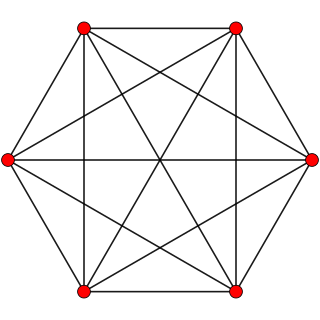



 ...
...




 ,
,  ...
...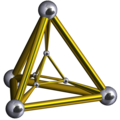

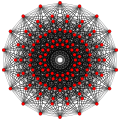
 ...
...




 ,
,  ...
...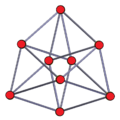

 ...
...


























